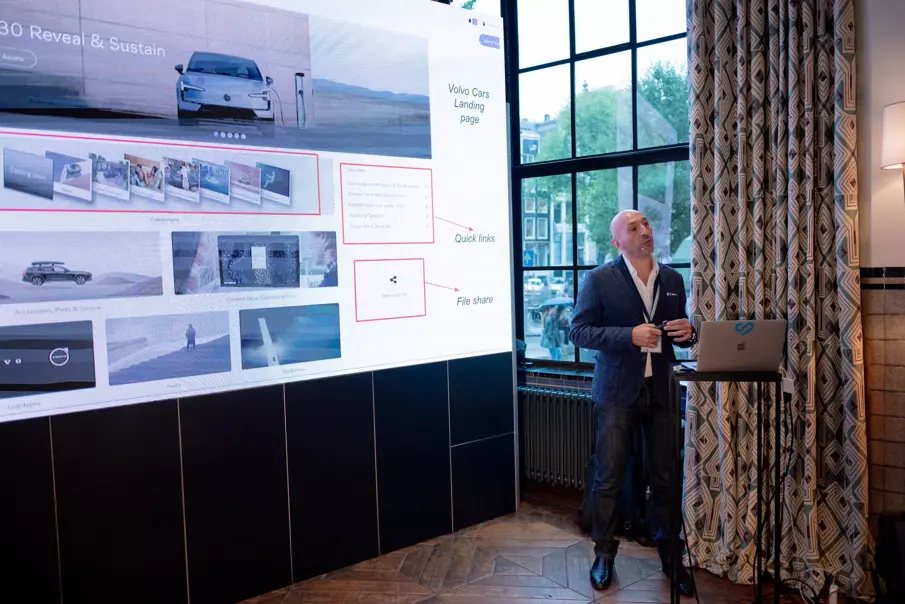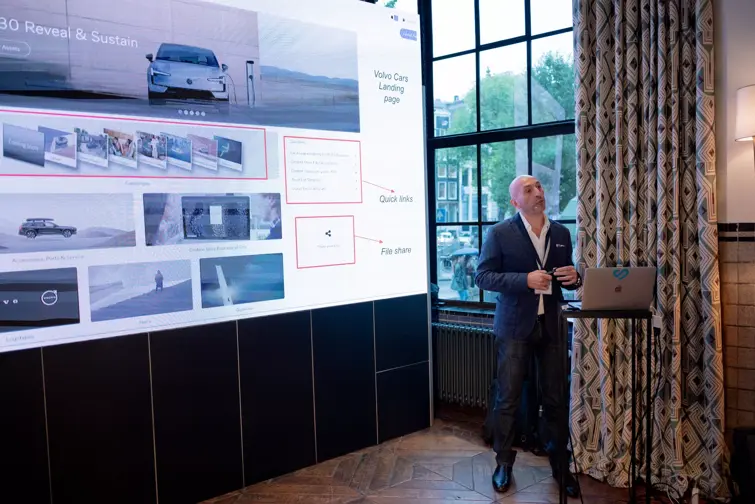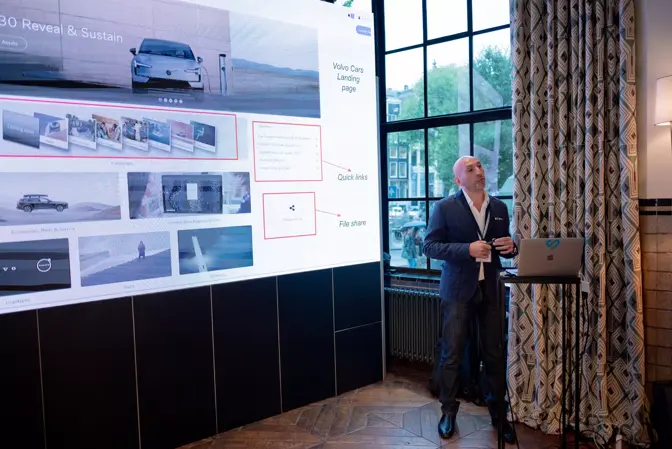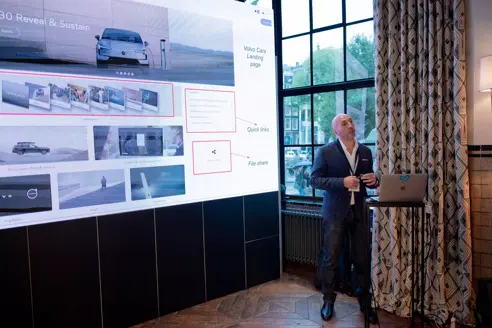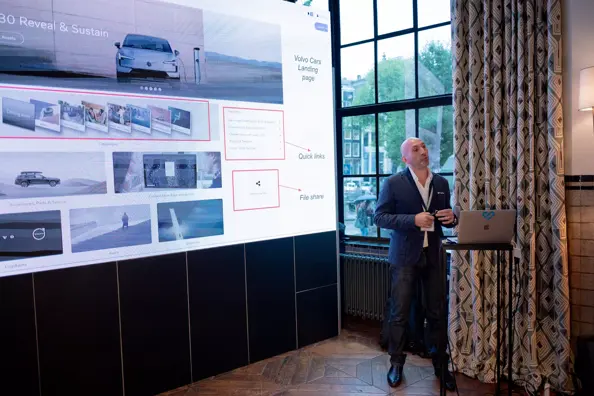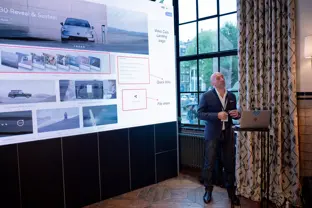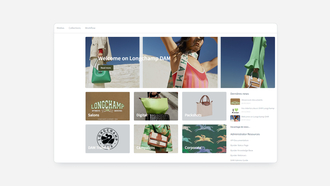Since its inception in 1927, the Swedish automotive brand Volvo has become synonymous with high-quality vehicles that people can rely on. By combining safety, sustainability, and a design that is distinctly Scandinavian, the company has achieved consistent success and a positive brand image for decades.
From humble beginnings, the Volvo Group is now a multinational giant: 104,000 employees. 13 brands. 190 markets. Production facilities in 18 countries. In 2022, net sales amounted to SEK 473 billion (EUR 44.5 billion).
So how does a company of Volvo’s size and scope manage its digital assets in a way that is efficient, scalable across markets, but also flexible to local market needs? In short, they use Bynder’s digital asset management platform.
Recorded live at Bynder’s Customer Spotlight Event in Amsterdam, Volvo’s Senior Asset Manager, Simon Atlassi, shares Volvo’s experiences using Bynder, which you can watch below.
We’re using Bynder as a global platform, available in six different languages.Simon Atlassi
Senior Asset Manager at Volvo
How Volvo is using Bynder
Branded as the ‘Volvo Content Store’ internally, Volvo’s Bynder solution includes the core digital asset management platform, supplemented with additional modules: Brand Guidelines and Asset Workflow. To help streamline the content lifecycle from creation to distribution – vital for enterprises of Volvo’s size – its Bynder solution also has a number of API integrations, including with Adobe and Salesforce Marketing Cloud.
With operations spread worldwide in multiple markets, Volvo ultimately wanted to centralize and scale how it managed digital marketing assets to achieve the following:
- Centralization of digital content in one solution
- More control to the central marketing team over how content is used
- Protect the confidentiality of digital assets
- Multilingual support to enable local marketers to search for files in their own language
- Faster distribution and go-to-market for content and campaigns (supported by the Salesforce Marketing Cloud integration)
- Empower greater self-sufficiency among local marketing teams (while adhering to brand guidelines)
We have about 80,000 assets in Volvo Content Store [Bynder], and about 20 TB of storage.Simon Atlassi
Senior Asset Manager at Volvo
Lessons learned: Tips from Volvo on how to onboard DAM smoothly
10,000 users are currently using Volvo’s Bynder solution. This includes approximately 5,000 employees, and 5,000 external stakeholders – the majority of whom are from creative agencies who support Volvo’s marketing efforts.
As a large enterprise with such an expansive use case, Volvo had plenty of insights to share on how companies considering their own DAM solution can ensure the implementation goes smoothly. Follow their lessons learned below.
1. Audit your assets before migrating to DAM
Having a rough idea of which assets you’d like to migrate to the DAM (if not all of them), and what goals you have for the solution is a great first step.
Make sure that prior to migration, the content you are trying to move over is in good shape. Because once you’ve done the migration, it’s going to be hard work to clean it up.Simon Atlassi
Senior Asset Manager at Volvo
For example, consider what your ‘evergreen’ assets are: your most essential, most used, most valuable assets. These will be the assets you’ll need in the DAM from day one. You can then work backward and create a priority list for assets to be migrated.
From there, you can define your taxonomy and metadata structure. This basically means how your files are classified (metaproperties), and the information (metadata) associated with each asset that makes it searchable and easy to find by users. For more advice on this, check out our guide to building a digital asset library taxonomy.
2. Take advantage of Bynder’s range of partners
Alongside Bynder’s dedicated onboarding experts who will support you throughout the process, many companies—like Volvo—take advantage of our partner network for a smooth transition.
Bynder has great partners for successful migrations. For instance, we’ve been working with VIM Group. They are very familiar with how the Bynder platform works and the taxonomy etc. If you do it right from the beginning, it will prevent a lot of headaches later on.Simon Atlassi
Senior Asset Manager at Volvo
Our partners help to facilitate onboarding, offer tailored consultancy on the best solution for your needs, and provide technical support relating to Bynder’s integrations. Learn more about Bynder’s partners here.
3. Define your processes and stick to them
If you create [DAM] processes and follow them strictly, that will help a lot. Think of processes in terms of how to upload assets and how to define your usage rights etc., so that everybody is working in the same way.Simon Atlassi
Senior Asset Manager at Volvo
Volvo was keen to emphasize that an ad-hoc, ‘on the fly’ approach to using your DAM is far from ideal. After all, one of the main strengths of a DAM is enabling clear, consistent processes surrounding how digital assets are managed that everyone can follow. That way, you’re able to scale processes and be a lot more efficient.
In more concrete terms, this could be defining content usage rights (who is allowed to upload/download assets), and when it comes to the migration, which stakeholders are responsible for the project.
4. Maintain the DAM as and when it’s needed
Particularly for large enterprises dealing with a high volume of digital assets, regularly reviewing your DAM processes and auditing your content helps make sure everyone can continue to get the most value from the platform. Does your file taxonomy still make sense? Are you archiving outdated content? Do new users need to be onboarded?
It [Bynder] really needs to be maintained on an ongoing basis. And one thing that has been helping me a lot with the Bynder platform at Volvo has been the use of Trello. This is a fantastic way of organizing your work.Simon Atlassi
Senior Asset Manager at Volvo
A great DAM platform also evolves with your needs and goals as they change. Maybe you’re looking to scale and automate the production of creative assets, add project workflow functionality, or add new integrations to your existing tech stack (like in Volvo’s case, who are currently trialing an integration with Microsoft 365).
Follow our 3 steps for a successful DAM migration
Before you kickstart your own DAM project, follow our best practices to make sure it’s as smooth as possible. Check out our 3 steps to prepare for a successful DAM migration. If you’re still not sure if DAM is right for you, why not arrange a free demo? We’ll be happy to answer any questions you may have and suggest a solution to fit your exact needs.
